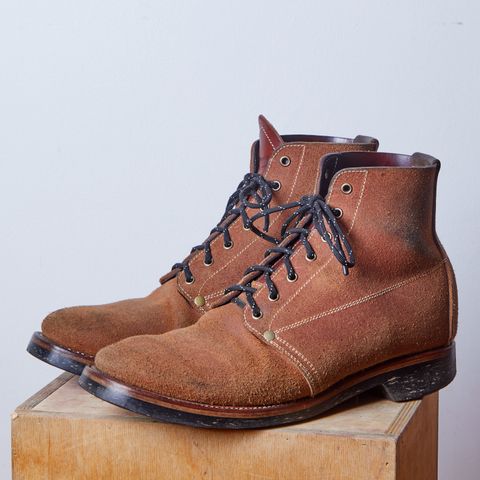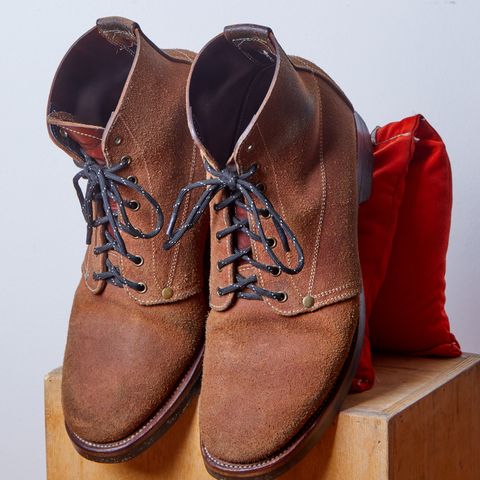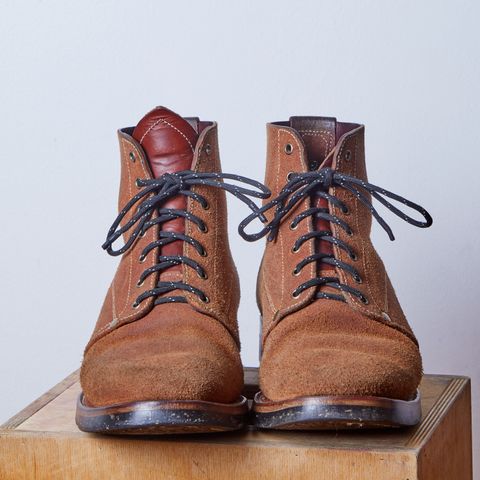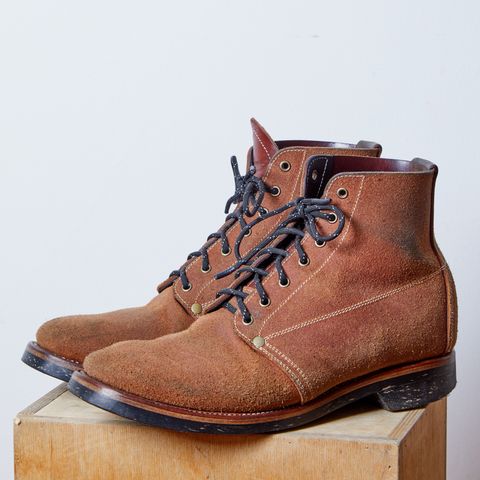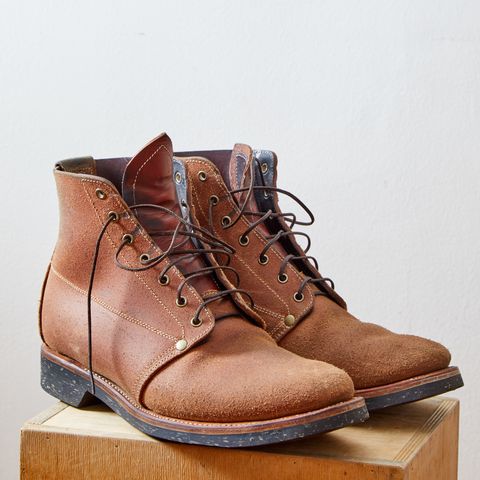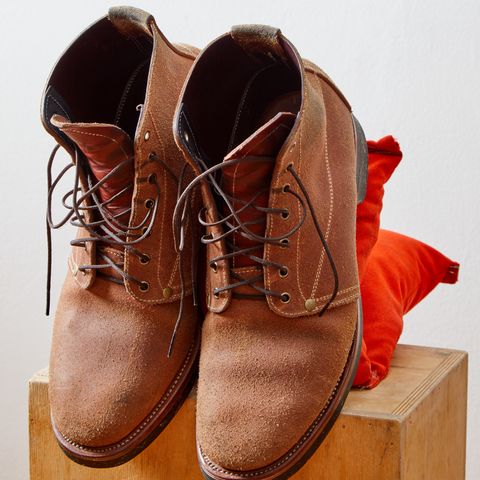Wickett & Craig Chestnut Oiled Latigo Roughout
Leather ColorAbout
Chestnut Oiled Latigo Roughout is a color variant of Wickett & Craig's Oiled Latigo Roughout leather featuring a rich brown tone that develops a pronounced patina over time. This vegetable-tanned leather combines the durability and oil-treated characteristics of oiled latigo with the distinctive texture of roughout finishing, where the flesh side of the hide is exposed as the exterior surface. The leather is produced through Wickett & Craig's traditional hot-dipping process in a proprietary mix of oils, waxes, and tallows, resulting in a weather-resistant material with a reddish-brown hue that darkens and gains character with use.
About
Chestnut Oiled Latigo Roughout is a color variant of Wickett & Craig's Oiled Latigo Roughout leather featuring a rich brown tone that develops a pronounced patina over time. This vegetable-tanned leather combines the durability and oil-treated characteristics of oiled latigo with the distinctive texture of roughout finishing, where the flesh side of the hide is exposed as the exterior surface. The leather is produced through Wickett & Craig's traditional hot-dipping process in a proprietary mix of oils, waxes, and tallows, resulting in a weather-resistant material with a reddish-brown hue that darkens and gains character with use.
Chestnut represents one of five standard colors in Wickett & Craig's Oiled Latigo line, which also includes Tan, Burgundy, Medium Brown, and Black. The leather is used primarily by bootmakers and leather crafters who value its combination of durability, distinctive appearance, and natural aging characteristics. When configured as roughout, the leather's flesh side provides a nubuck or suede-like texture while retaining the full-grain leather's structural integrity on the interior.
Product Specifications
Wickett & Craig Chestnut Oiled Latigo is available in weights ranging from 2-3 oz. to 12-14 oz., allowing bootmakers to select appropriate thickness for different applications. The leather is sold by side and back, with average sides measuring 24-27 square feet and average backs measuring 18-20 square feet. The material can be ordered in different tempers, from firmer to softer, depending on the intended use.
The leather undergoes custom splitting and refinishing when configured for roughout applications. When split to 4/5 oz. thickness and refinished on the flesh side, the material becomes suitable for footwear, bags, wallets, briefcases, and other small goods. This refinishing process exposes the corium layer of the hide, creating the characteristic rough texture while maintaining the leather's durability and structural properties.
Pricing varies by grade, with Standard Grade ranging from $241-$274 per square foot depending on thickness, Utility Grade priced at $225-$258 per square foot, and Special Grade at $211-$241 per square foot. Custom splitting and refinishing services are available for additional cost.
Material Properties
The chestnut oiled latigo undergoes hot-dipping in a special mix of oils, waxes, and tallows, making it strong, pliable, and fully conditioned. This treatment creates a weather-resistant and water-repellent surface with a distinguished depth of color characteristic of lighter oiled latigo tones. The high oil concentration provides the material's protective qualities but can cause potential leaching, requiring careful consideration in product design.
The leather displays a pull-up effect, where the oils within the leather shift when the material is bent or stretched, creating lighter areas that return to the base color when released. This pull-up characteristic becomes more pronounced in lighter colors like chestnut and contributes to the leather's dynamic appearance during use.
When configured as roughout, the flesh side presents a texture that varies depending on how much untreated corium is left exposed. If only the junction between grain and flesh is left untreated, the texture will be finer, similar to nubuck. More extensive corium exposure results in a rougher, more suede-like appearance. The back side remains similar to untreated smooth full-grain leather, making roughout suitable for unlined footwear and other applications where the interior surface requires smoothness.
Aging and Patina Development
Chestnut oiled latigo roughout develops character through wear and exposure to environmental elements. The leather slowly darkens over its lifetime, with the rate and pattern of darkening influenced by usage patterns, exposure to moisture, and contact with other materials. High-use areas tend to develop a reddish-brown color distinct from less-worn sections, creating a visual map of the item's history.
The leather readily takes on color from indigo denim through dye transfer, creating blue tones in areas of frequent contact. Water marks and exposure to oils from handling contribute additional variation in color and tone. This natural aging process, rather than being considered a flaw, is valued by users who appreciate leather that visually chronicles its use history.
The patina development makes each item unique to its owner, with no two pieces aging identically. The combination of the chestnut base color, the pull-up effect from the oil treatment, and the environmental influences creates a complex, evolving appearance that heritage footwear enthusiasts seek in high-quality leather goods.
Wear Characteristics and Maintenance
Chestnut oiled latigo roughout provides a relatively easy break-in period compared to stiffer leather types. Once broken in, the material holds its shape well while continuing to develop flexibility in areas of repeated flexing. The leather's behavior during break-in resembles that of saddle leather, becoming more supple and comfortable with age while maintaining structural integrity.
The material shows visible marks, scuffs, and stains more readily than smoother leather types due to its roughout texture and lighter color. Nicks appear easily compared to darker or grain-out leathers. However, conditioning treatments greatly mitigate the visibility of these marks, with regular maintenance helping to blend minor damage into the overall patina pattern.
For maintenance, the roughout surface requires different care than grain-out leather. Dirt removal is accomplished with a wire brush or damp cloth, with the textured surface releasing debris more readily than smooth surfaces. If the leather becomes wet, air drying away from direct heat sources prevents damage to the oils and waxes in the material. When the leather shows signs of drying or cracking, application of leather conditioner restores suppleness. Leather protection sprays provide additional water and stain resistance, though users should test such products on small, hidden areas before full application to ensure compatibility with the specific finish.
Applications and Usage
Bootmakers represent the primary users of chestnut oiled latigo roughout, with the material appearing in work boots, heritage boots, and outdoor footwear. Caswell Boot Company has produced multiple boot models featuring this leather, including the Carver and Shaw styles. The material's durability and resistance to visible wear make it suitable for boots intended for rugged use while maintaining an aesthetic valued in the heritage footwear market.
Beyond footwear, the leather finds application in strap goods, bags, wallets, and briefcases when split to appropriate weights. The roughout finish provides a distinctive texture for these items while offering the practical benefits of oil-treated vegetable-tanned leather. The flesh-side-out orientation helps hide wear and provides a more static appearance compared to smooth leather, making it appropriate for items subjected to frequent handling and environmental exposure.
The leather's suitability for outdoor and work applications stems from its water resistance, abrasion resistance, and ability to withstand harsh environments without showing damage as prominently as smooth leather. These properties, combined with the material's natural aging characteristics, have established it as a choice for users seeking both functionality and the aesthetic development that comes with extended use.
Manufacturing and Sourcing
Wickett & Craig, founded in 1867 and located in Curwensville, Pennsylvania, is one of only two remaining vegetable tanneries in the United States. The company employs a labor-intensive, natural, and environmentally conscious veg-tanning process passed down through generations of tannery workers. This traditional method produces leathers recognized for their depth of color and capacity to develop rich patina over time.
The oiled latigo production process involves vegetable tanning followed by the hot-dipping treatment in oils, waxes, and tallows. For roughout applications, the tanned and treated leather undergoes additional splitting and refinishing operations to expose and prepare the flesh side for exterior use. The company offers custom splitting and refinishing services, allowing customers to specify exact weights and surface characteristics for their intended applications.
The tannery's position as one of the last American vegetable tanneries gives its products significance beyond their material properties. Bootmakers and leather goods manufacturers seeking domestically-produced, traditionally-made leather materials select Wickett & Craig products for both quality and provenance. The chestnut oiled latigo roughout represents a specific intersection of traditional tanning methods, specialized finishing techniques, and a color choice valued for its aging characteristics.
References
"Oiled Latigo". Wickett-Craig. Retrieved October 10, 2025.
"Carver II - Chestnut Oiled Latigo". Caswell Boot Company. Retrieved October 10, 2025.
